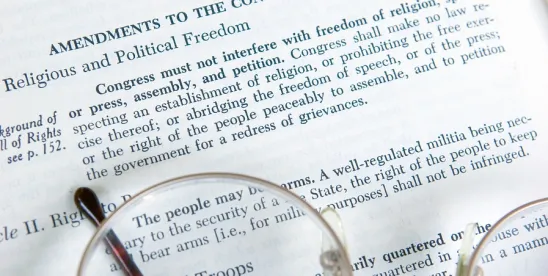On June 23, 2021, the Supreme Court of the United States, in an 8-1 decision, affirmed the rulings of both the United States District Court for the Middle District of Pennsylvania and the Third Circuit Court of Appeals, when it held that a school district violated the First Amendment in its discipline of a high school student in response to a social media post. Mahanoy Area School District v. B.L., concerned a high school student’s posts on social media (Snapchat), one of which included vulgar language, in which she expressed frustrations and criticism for not making the varsity cheerleading team. Specifically, one of the posts included a “selfie” of the Student and a friend, both giving the middle finger, along with the message “f*** school, f*** softball, f*** cheer, f*** everything.” The image was posted over the weekend, while she was off-campus at a convenience store. As a punishment for the posts, school officials suspended the student from the junior varsity cheerleading team for a year. The student and her parents sought relief in federal court arguing that the school’s punishment of the student’s speech violated her First Amendment rights.
The District argued that it was within its rights to suspend the student per the previous Supreme Court decision in Tinker v. Des Moines Independent Community School District, which held that school officials could “regulate speech that would materially and substantially disrupt the work and discipline of the school.” The Court did not go as far as issuing a blanket prohibition with regard to punishment for off-campus speech, and even cited examples in which a school district may be required to act – such as bullying or harassment, threats towards students or teachers, failure to follow school rules, and security breaches of school devices. The Court emphasized the fact that “When it comes to political or religious speech that occurs outside school or a school program or activity, the school will have a heavy burden to justify intervention.”
In its ruling, the Court explained that the aspects of off-campus speech which “diminish the strength” that a district can regulate such speech are: (1) that off-campus speech will typically fall within the realm of parental responsibility rather than the responsibility of school officials; (2) in the perspective of a student, regulations of off-campus speech combined with regulations of on-campus speech “include all the speech a student utters during the full 24-hour day”; and (3) that schools have an interest in protecting a student’s unpopular expression, especially when the expression takes place off-campus, because “America’s public schools are the nurseries of democracy.”
The Court noted that if the student were an adult at the time of the incident, that these social media posts would have significant protection under the First Amendment, and that the language did not contain “fighting words” and did not meet the definition of “obscene” as understood by the Court. While this ruling allows for future cases to better define the scope of a school district’s ability to regulate off-campus speech, it provides one example of a school district over-stepping its bounds under the First Amendment. As Justice Breyer held, “sometimes it is necessary to protect the superfluous in order to preserve the necessary.”
Hailee Kepchar, Law Clerk contributed to this article.



 />i
/>i
